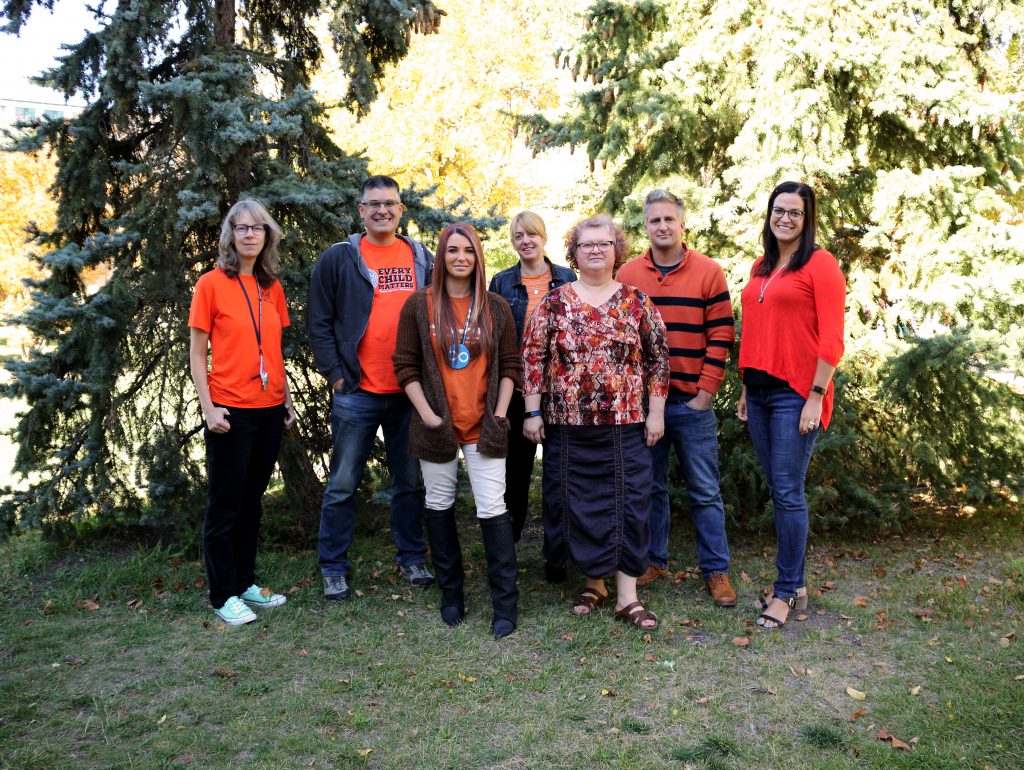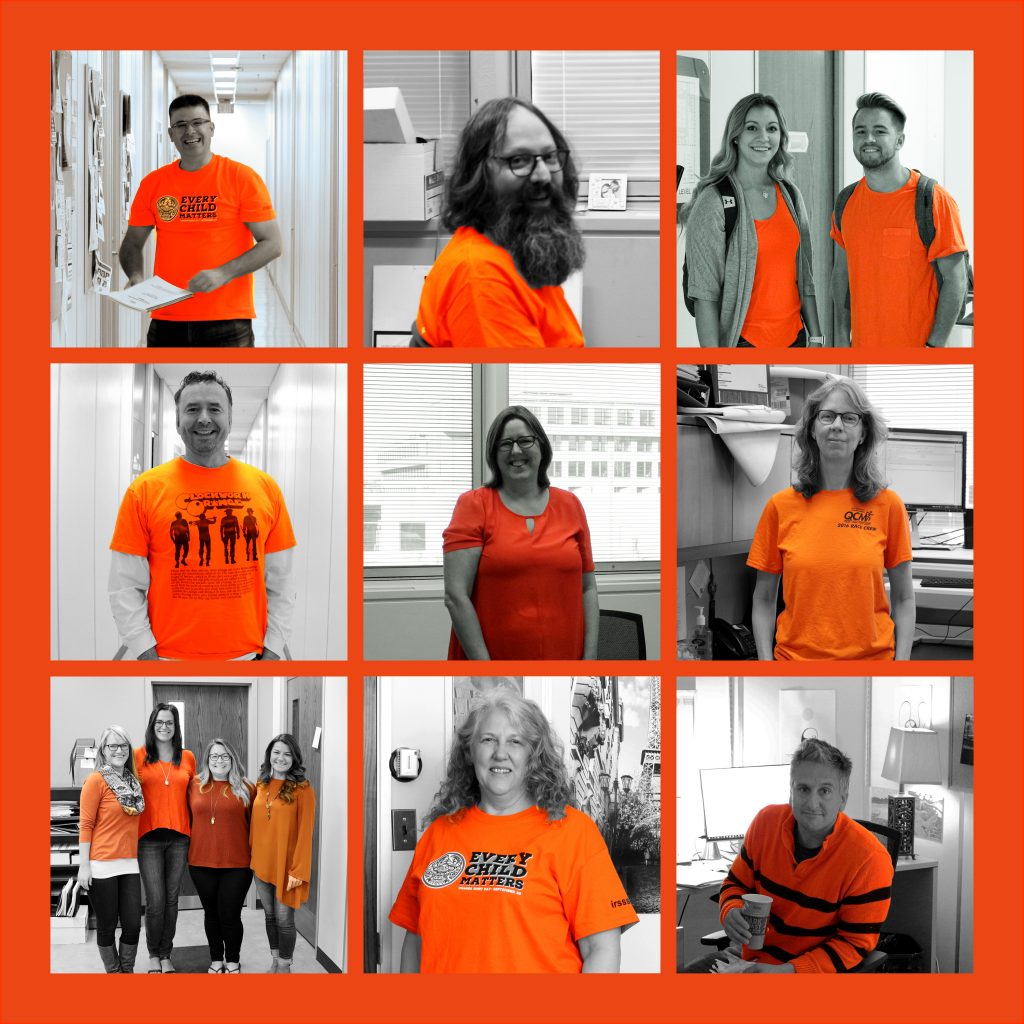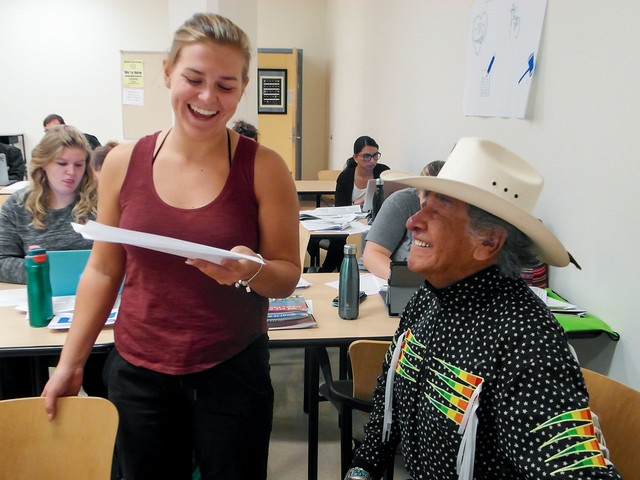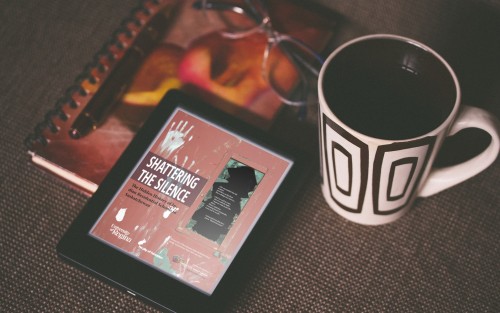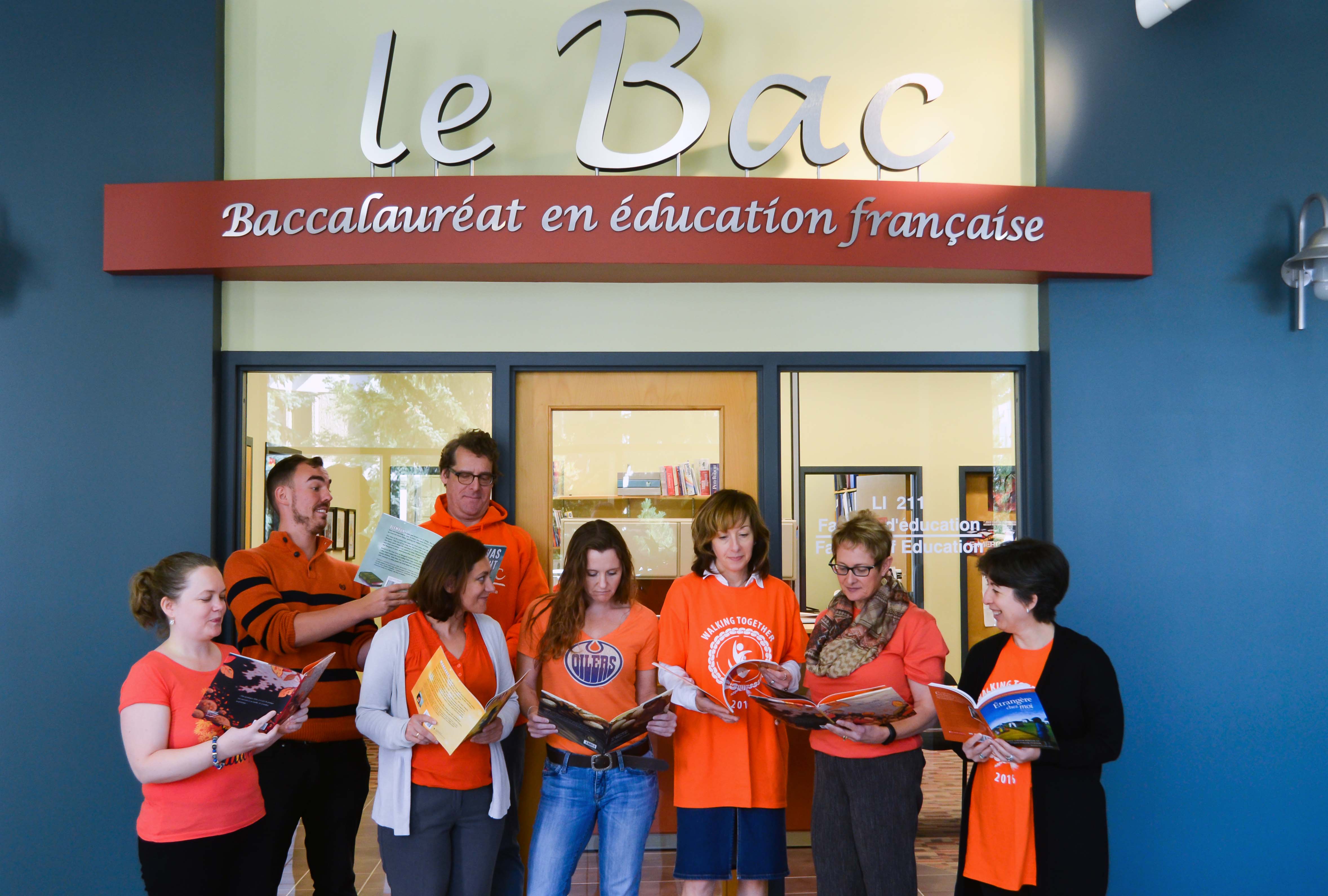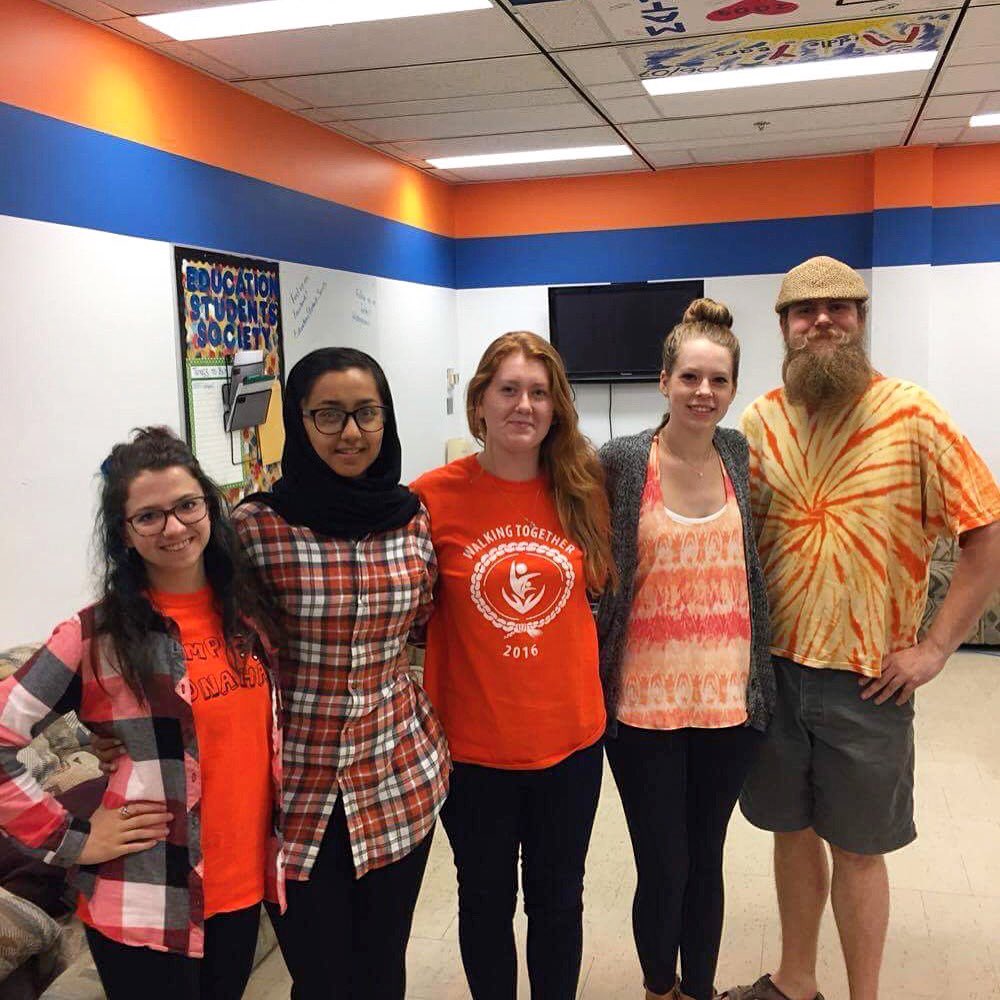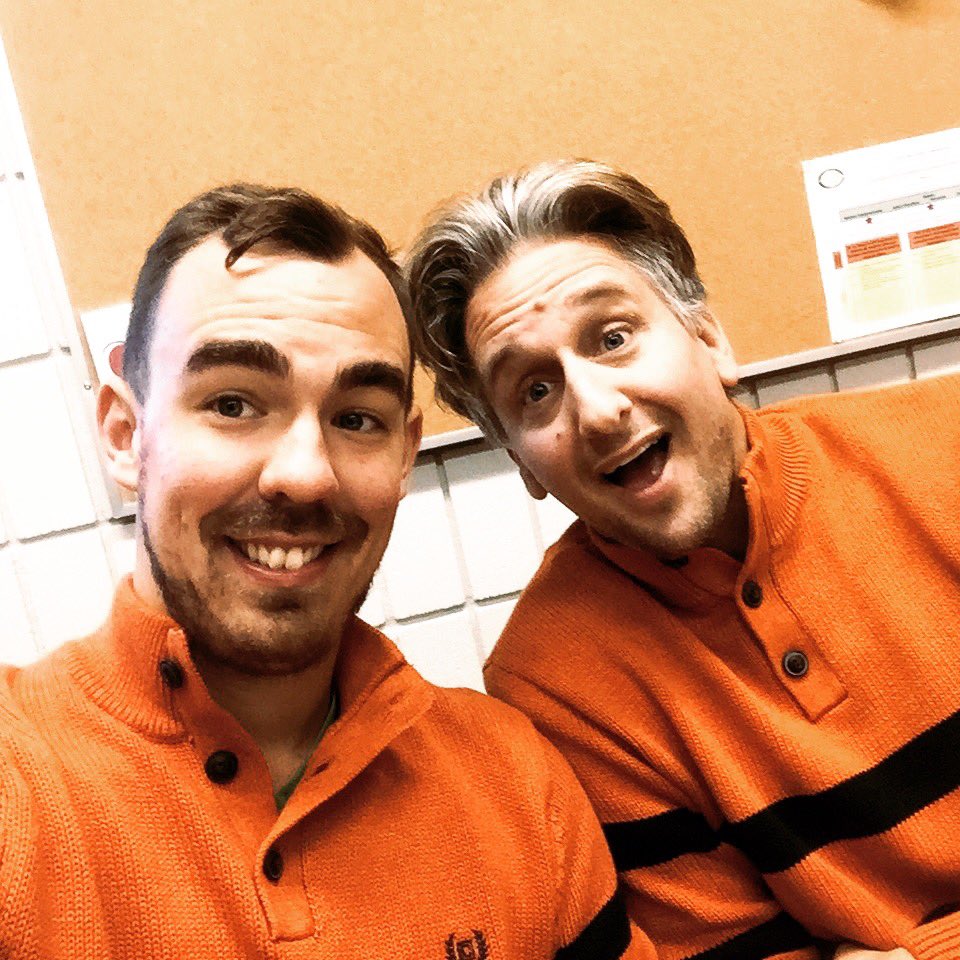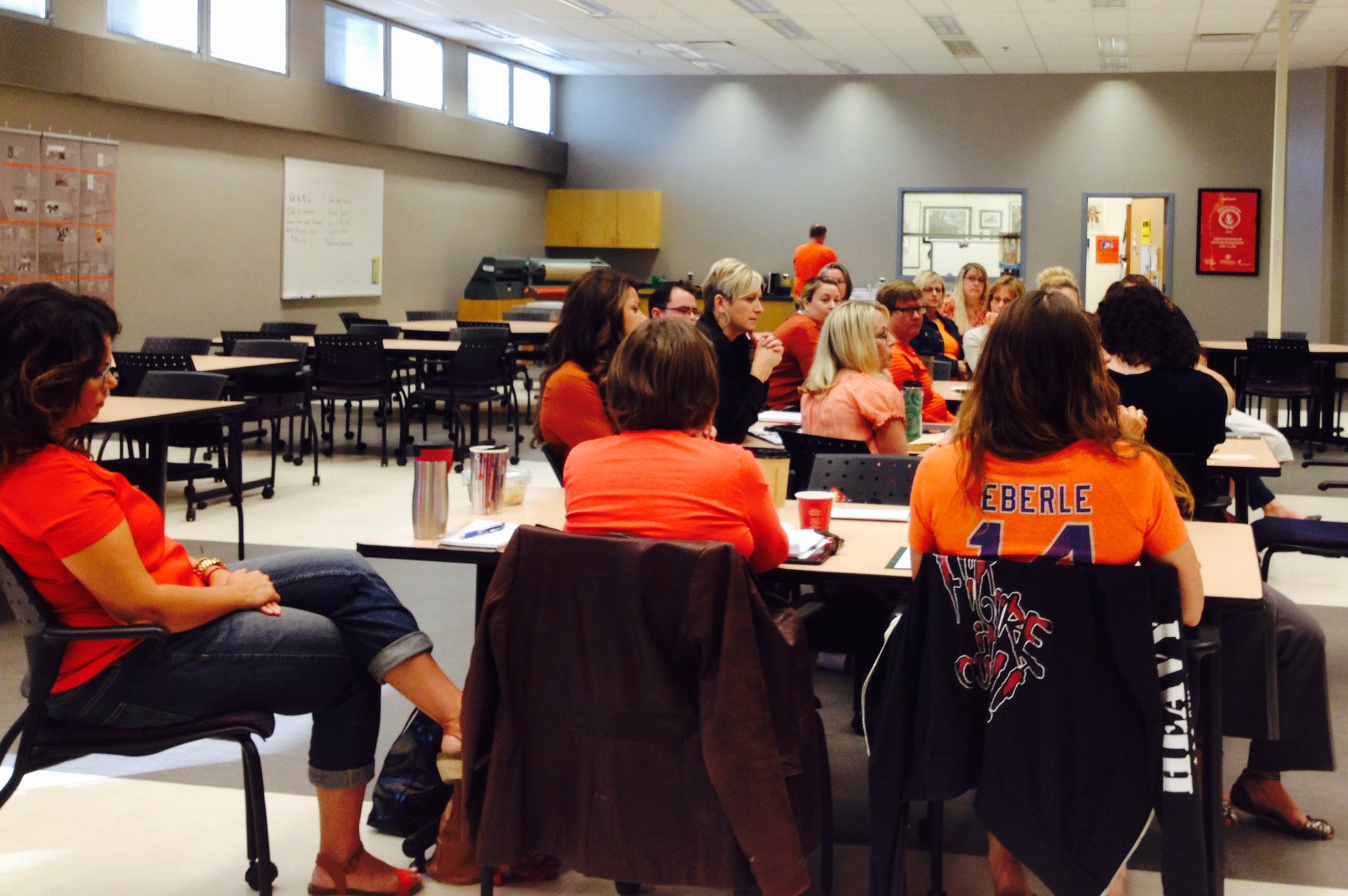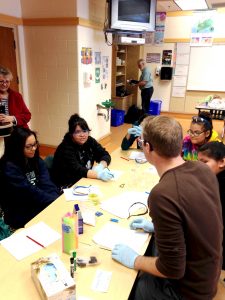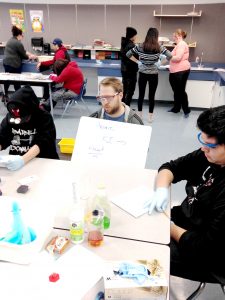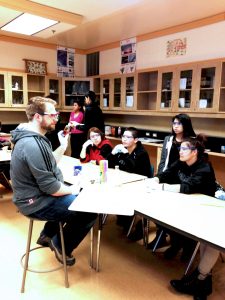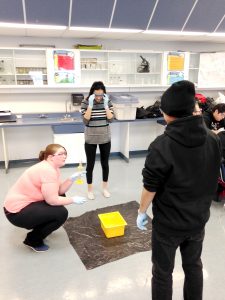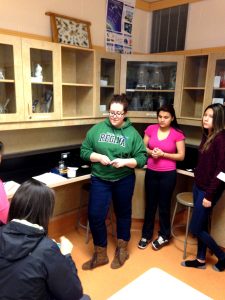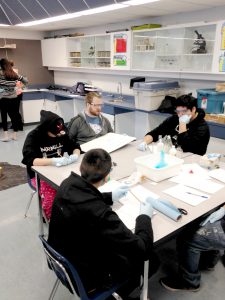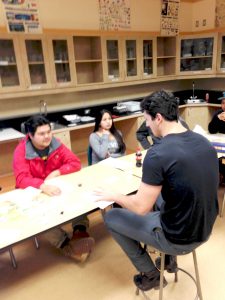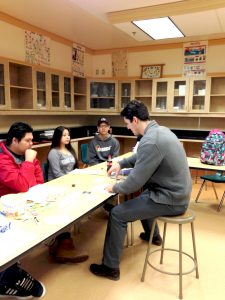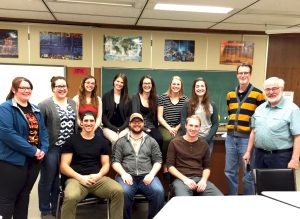Orange Shirt Day is Saturday, September 30, but the faculty, staff and students have dressed in orange shirts today to commemorate those children who attended Indian residential schools, and to show our support and commitment to reconciliation and hope for the future generations of children.
Category: Truth and Reconciliation
Pre-interns participate in treaty education
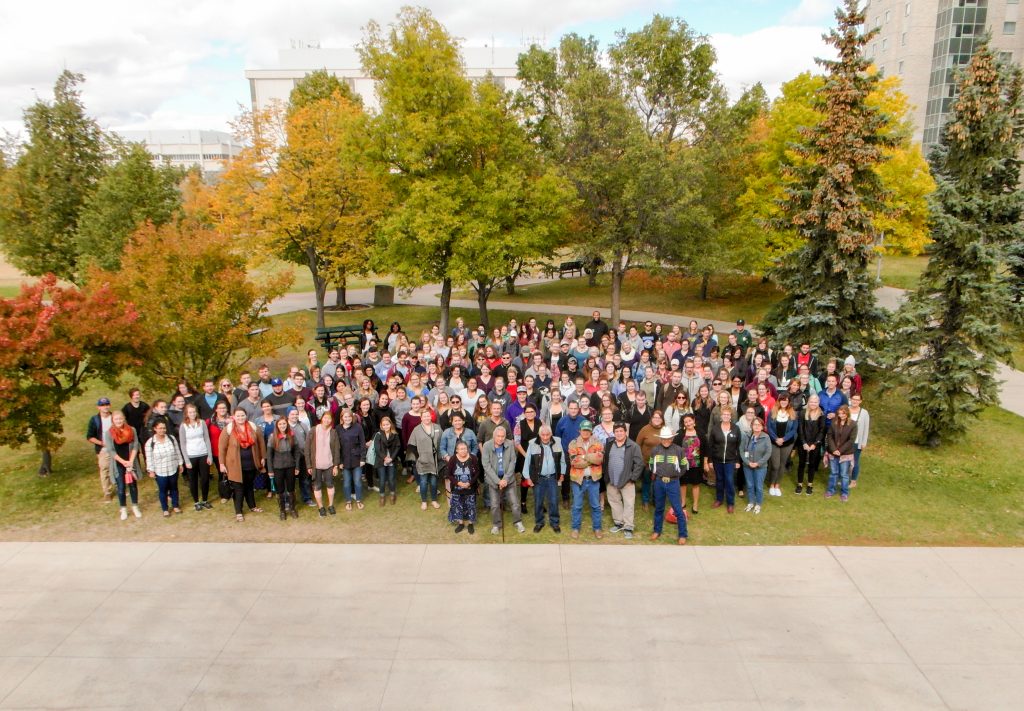
Before third-year pre-interns go into schools for their 3-week field experiences, they participate in extensive professional development. Treaty education is a significant part of their learning experience.
This fall (September 13), three bus loads of pre-interns went to the Treaty 4 Gathering at Fort Qu’Appelle, and while there, experienced the Kairos Blanket Exercise along with Treaty 4 cultural activities.
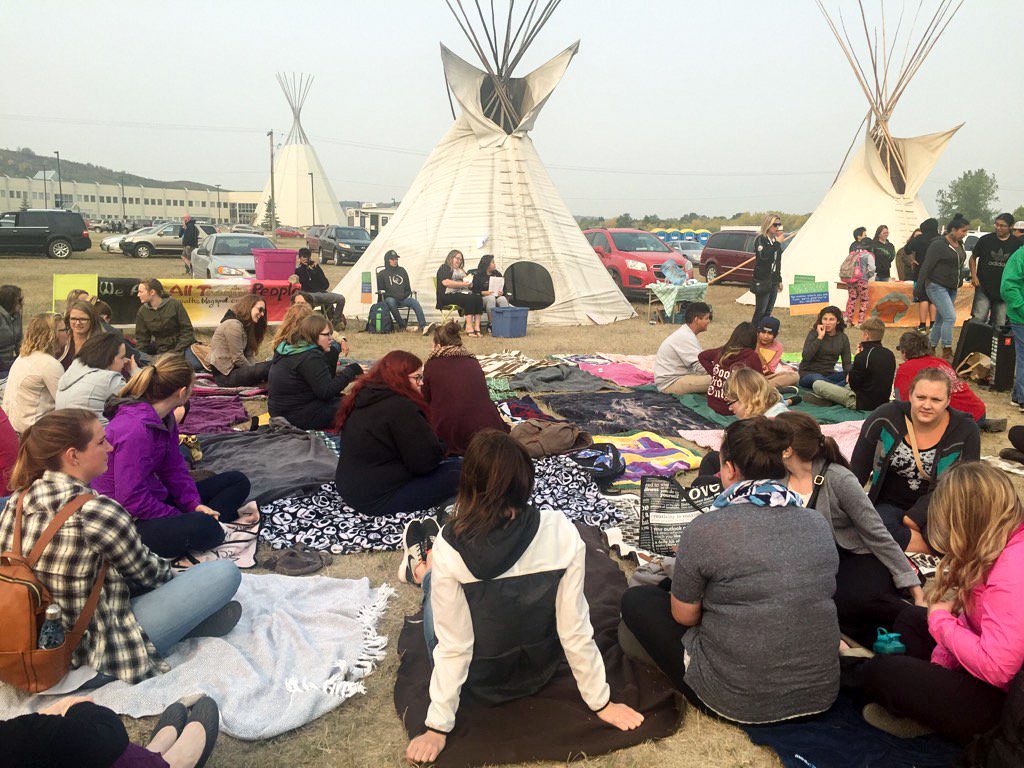
Ten facilitators from the Office of Treaty Commissioners, 10 elders, and 10 faculty and staff worked with 270 pre-interns on September 23 and 24 at the University of Regina. Students were given opportunities to interact with Elders and received instruction on treaties and treaty education.
Place cursor over the photo above to scroll through photo gallery. (Photos courtesy of Instructor Julie Machnaik)
Twitter talk:
Feeling inspired after a great weekend of professional development! Thank you for the amazing opportunities @URFacofEd pic.twitter.com/VL0TWL2CGf
— Anessa Eckert (@AnessaEckert) September 25, 2017
Working with Third year Education students @URFacofEd with @TreatyOfficeSK pic.twitter.com/GMJm2Gg8TH
— Cort Dogniez (@CDogniez) September 23, 2017
Susan Beaudin presenting @URFacofEd OTC @treatyconferencesk FANTASTIC PD pic.twitter.com/WIMKygy5au
— Julie Machnaik ᔫᓕ (@jmachnaik) September 24, 2017
@URFacofEd planning with Nelson “Under the Sun” K-8 Teaching Treaties in the Classroom” kits. Thx Susan 4 sharing! pic.twitter.com/yv5Whofkv4
— Julie Machnaik ᔫᓕ (@jmachnaik) September 24, 2017
Today we are talking about resources that will help us in our classrooms and lesson plans! #treatyeducation #universityofregina @URFacofEd pic.twitter.com/BTKRYduztK
— Laneise Scharback (@laneise2016) September 24, 2017
Had a wonderful time at Day 1 of the Treaty Ed Conference, learning about Treaty 4 and other Saskatchewan Treaties. Thank you, @URFacofEd!
— zunaira (@zunaira_t) September 23, 2017
Amazing blanket exercise experience at Treaty 4 Gathering for @URFacofEd preinterns. Thx @TreatyWalks @reilabird pic.twitter.com/CNbIyI5GTC
— Julie Machnaik ᔫᓕ (@jmachnaik) September 13, 2017
270 @URFacofEd Preinterns+10 Faculty/staff+10 @TreatyOfficeSK facilitators+10 Elders = AMAZING 300 TREATY PD TEAM! pic.twitter.com/PCSVtqKhoc
— Julie Machnaik ᔫᓕ (@jmachnaik) September 24, 2017
A great resource to add to your professional collection! #urpreinterns https://t.co/wSTocguZpG
— Julie Machnaik ᔫᓕ (@jmachnaik) September 24, 2017
History of Indian residential schools in Saskatchewan ebook now available
The Shattering the Silence: The Hidden History of Indian Residential Schools in Saskatchewan ebook is a Project of Heart Saskatchewan resource for teachers published by the Faculty of Education, University of Regina.
This book extracts, reorganizes, and compiles the school-specific Saskatchewan elements of the NCTR reports and archived school files as well as incorporating other research and former student accounts that have been recorded and published online. It is an informative and accessible resource for teaching and learning about Indian residential schools in Saskatchewan.
Follow the link to DOWNLOAD YOUR FREE COPY of Shattering the Silence: The Hidden History of Indian Residential Schools in Saskatchewan
Reconciliation Garden
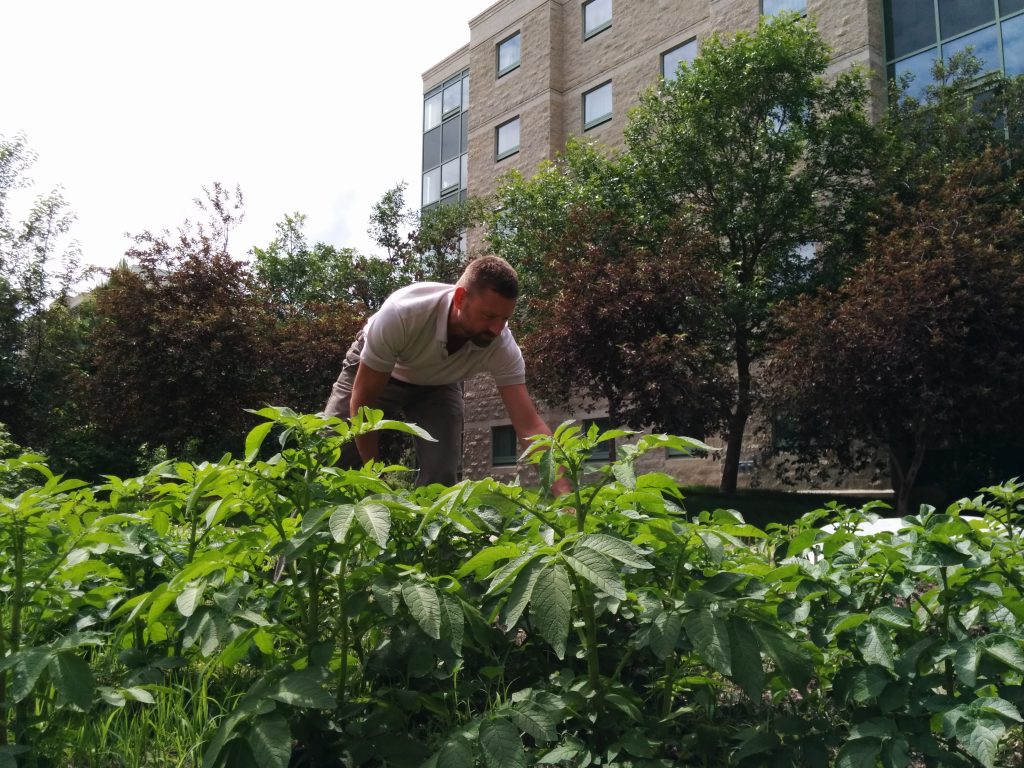
In spring 2017, The Faculty of Education’s Indigenous Family Therapies Class (EPSY 870AB) in partnership with the Indigenous Peoples’ Health Research Centre (IPHRC) have planted a Project of Heart Reconciliation Garden.
The Objectives of this project in our class were:
• To present a culturally-competent counseling intervention by integrating Indigenous knowledge within the more modern ecopsychology approach;
• To encourage a three-way therapeutic alliance between counselor, client, and nature as co-therapist;
• To deconstruct the modern therapeutic “space” by promoting nature-based therapeutic interventions; and
• To identify gardening as a social justice approach.
We based our garden design around the Honouring Memories Planting Dreams
Celebrated in May and June, Honouring Memories, Planting Dreams invites individuals and organizations to join in reconciliation by planting heart gardens in their communities. Heart gardens honour residential school survivors and their families, as well as the legacy of the Truth and Reconciliation Commission of Canada. Each heart represents the memory of a child lost to the residential school system, and the act of planting represents that individual’s commitment to finding their place in reconciliation. In 2016, more than 6500 hearts were planted in gardens across Canada.
Videos
For more information about the Reconciliation garden, please contact:
JoLee Sasakamoose – JoLee.Sasakamoose@uregina.ca
John Klein – John.Klein@uregina.ca
Gallery
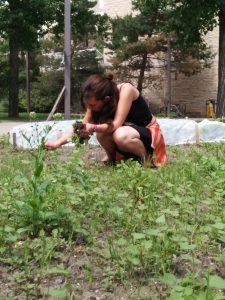
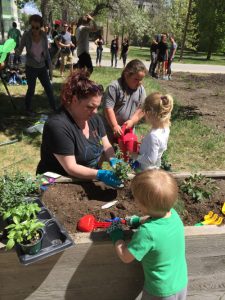
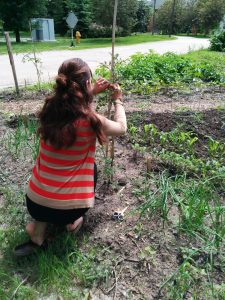
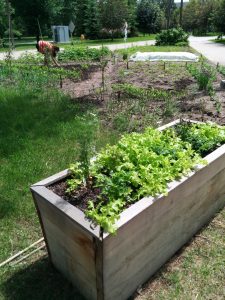
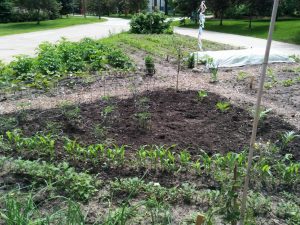
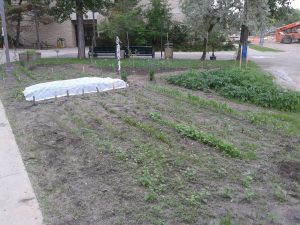 Reposting from https://reginaediblecampus.wordpress.com/le-potager/
Reposting from https://reginaediblecampus.wordpress.com/le-potager/
Dave Nevill’s Sweat Lodge Experience

The following story was written by Dave Nevill (a career counsellor at Ituna School in the Horizon School Division and an Education graduate student) as a requirement for Dr. JoLee Sasakamoose’s Educational Psychology 824 course. He entitled it, “First Nations Group Therapy: A Sweat Lodge Experience.” This story was submitted to Education News by Dr. JoLee Sasakamoose.
As the last vestiges of light shrunk from sight at the far side of the lodge, I could feel the warm embrace of shared humanity with the confines of the small, cramped space. As a relative newcomer to this ceremony and healing center, I was welcomed into the congregation; I did not feel alien, awkward, or foreign. The pitch darkness and intense heat surrounded me in its urgent grip and I began to feel a connection to something larger than myself, a sense of community, a healing presence, and an association with the wisdom of the Creator. I was drawn into the spiritual ritual as one of them as if in answer to the bundle of prayers and expressed gratitude echoing throughout the dark lodge. As the day drew closer that I would attend the sweat lodge at the First Nations Healing Center in Fort Qu’Appelle, my apprehension grew. This was not going to be my first sweat either. Having experienced four previous sweats fifteen years earlier at Muskeg First Nation Reserve, I had a very good idea what to expect. However, I was attending this sweat in a different community, with people I had never met, in a ceremony that I didn’t fully understand, in a situation definitely outside my comfort zone. As I later realized, this sweat proved to introduce me to a larger experience than I had previously been exposed to.
To alleviate my anxiety somewhat, I chose to call the Healing Hospital a couple of days before and find out the protocols for the event. I found out the location, time, and materials needed. I picked up a bag of oranges for my offering to the feast after the event and a carton of cigarettes for a deeper prayer offering during the ceremony. I didn’t know how to offer any of these items to the ritual, so some things would have to be left to learning on the spot. Upon my arrival prior to the event, I was met by Darla and Char who were also participating; they had found out where the sweat would take place and I followed them to the building, talking a little apprehensively. Several First Nations men were lounging casually outside the building and they eyed us curiously as we walked up. They responded to our approach with a friendly and welcoming demeanor, soon to be followed by introductions, handshakes, and some good-natured ribbing. I settled in to wait with them as my two companions entered the building to join the other women. The fire heating up the rocks crackled nearby.
I sat beside a man who turned out to be their spiritual elder, or knowledge keeper as he preferred to be called. After conversing for a while, he sensed that I was sensitive and somewhat knowledgeable about First Nation’s issues and he expressed his feelings about living conditions and treatment within Canada as our election approached. He was shocked that I had been relatively ignorant of residential school issues and abuse up to about two years ago; I suggested the white man wrote the history books to suit themselves.
The ceremony started with a sweet grass cleansing of ourselves and our prayer offerings. As I was unfamiliar with the proceedings, the knowledge keeper told me to do everything his buddy did and I would be okay; I watched him closely anyway for guidance to make sure I didn’t mess something up with the ceremony. I was surprised when the pipe was passed around the circle of men and it was given to me to participate. Maybe I was given the honor of smoking the pipe as I was making a tobacco offering for a prayer and this was the way for the smoke to carry my prayers to the Creator, according to their traditions. Never having smoked a piper before, I did the best I could and passed it on. Several of the men handled the pipe in a particular way after smoking it as if in prayer to the Creator.
A clipboard was passed around which we were all asked to sign and indicate our reasons for attending the sweat. Most people chose spiritual and ceremonial from the list including emotional, mental, physical and social realms. I went with the crowd and chose those as well, even though I would have liked to pick emotional and mental. At this stage of unfamiliarity, I didn’t want to stray too far from the norm and I didn’t necessarily come to the sweat to gain clarity on any personal issues. After the knowledge keeper did extensive prayers for several of the other men and women, he called me over and asked me what type of prayer I was looking for. Not sure I myself, I hesitated. He helped me out by suggesting a prayer of thanks and I quickly assented. I knelt by him and he spoke a prayer in Cree for me.
The first round of the sweat soon followed the prayers. After removing my shirt, I crawled into the far side of the sweat lodge in just my shorts and a towel over my neck, beside the knowledge keeper as he indicated. The lodge was about four feet high and encompassed half the room, in a circular shape, and was covered with an extensive layer of blankets. I waited in silent anticipation as the rest of the group of men came inside and some of the hot, glowing rocks from the fire were gently placed in the center container of the lodge. I could feel the heat they generated in the small space. Each rock was sprinkled with sweet grass to cleanse it as it was dropped into the pot. The women and children were the last to crawl into the cramped lodge and the blankets then were draped over the door. Pitch darkness descended over the small space and congregation, except for a faint glow from the rocks. The sweat ceremony was about to begin.
The knowledge keeper started the round by offering prayers for various members of the group, including the family, which sponsored the event and were attending. After each offered prayer, he would splash some water on the hot rocks in the center. There was a slight pause before the heat enveloped the others and me. A murmur of assent rose from the room in answer to the prayers, splashes and heat. He gave thanks to the Creator for answering their prayers and started singing in Cree. We were all asked to pray in our own way as part of the ceremony. Several songs and prayers followed the first, accompanied by more splashes and waves of heat. I remained quiet throughout the first round and just became a part of the group process. After about ten minutes, a call was made to open the doors and many people exited the lodge for a break from the heat. I remained in the lodge and just relaxed.
Subsequent rounds were led by different people, including one of the elder women, whom the men suggested would make it a very hot round. They all followed the same process, prayers, and offers of gratitude to the Creator, splashes and waves of heat. The heat became more intense in the later rounds and I was forced several times towards the end of the round to cover my head, shoulders and mouth to deal with the intense heat. I even tried to participate in the singing on the fourth round as I felt a part of the communal ritual. I’m sure I butchered the song but felt good about it anyway. I exited the lodge with many of the others at the end of the second, third and fourth rounds too as I needed a break from the heat as well. I would crawl back into the lodge with the other men as more glowing rocks were brought in and deposited in the middle container. Comments were made when a particular big rock was deposited; that was going to send off some real steam.
I was struck and awed by the perceived power of prayer that was deeply felt by the participants in the sweat. They truly believed that the Creator would intervene in their everyday lives if the right prayers were offered to him through this ritual sweat. The power of this belief had helped many members of the congregation overcome personal hardships, stress, and illness. I was also deeply impressed by the sense of community that pervaded the scene; these people were not alone. They were surrounded by their communal family who, by participating in the ritual with them, would support them to overcome their trials and become whole again.
This shared experience was evident in their conversations after each round, a certain kinship with each other: They were a part of something that made them whole as individuals. It was an experience of shared hardship, of a mutual connection through an activity that required some courage, mental fortitude, and physical endurance. Char mentioned afterward that she had birthed two children and that knowledge alone helped her endure the most difficult parts of the experience.
In a sense, the sweat lodge can become a powerful healing agent for any nation and any individual who is willing to participate in the collective experience and gain support and encouragement from family, friends, community and the Creator, through a sacred ritual that pulls participants outside their comfort zone. This type of communal belonging is obviously very special to these First Nation’s people. It speaks to who they are as a people; it is part of their identity. Many kids were at the sweat and it was obviously extremely important that the essence of the ritual be passed on to the children of the community. Three generations were represented in this lodge experience. One might think that maybe they would want to keep that ‘specialness’ to themselves to avoid contamination. But they don’t, and that is a truly amazing feature of these people.
I have been part of the Catholic community for many years as a non-believer and never once have I felt the same sense of belonging and openness to the heart of their ceremonies as I felt in my first sweat lodge in the Fort Qu’Appelle community. They opened up their ceremony to three outsiders with open arms and wrapped us up in their communal embrace like we were one of them. Granted, there were some suspicious glances from some, which you can hardly blame them for, considering what the white man has done to them and how they continue to be treated. There are some sexist aspects to the ceremony that some women would object to. Women had to cover their legs, were only allowed in the sweat after the men and couldn’t participate in the pipe ceremony.♠ But the First Nations people are truly forgiving and generous in that they invite us outsiders to participate with them in one of their most sacred rituals as if three hundred years of history is suspended for the moment. If I can feel the power of this group embrace, one who is not a believer and not a member of their community, what could this do for someone who is one of them and is a believer?
For counseling, the therapeutic benefits are palpable, especially for First Nations children and adults who can identify with the shared belief structure. The collective embrace of the community surrounding an individual in need, and drawing them into their collective, would have a very powerful healing and supportive component. I witnessed the power of the community in my initial sweat experience with them and that communal embrace is the key. I have a sauna at home, and a sweat without the community is just a good sweat. I could see the benefit for voluntary participation of any aged individuals who are experiencing grief, depression, anxiety, addiction or a crisis in their lives, particularly those individuals where community support and kinship is more important than personal disclosure and in-depth counseling.
I made an attempt to participate in the fifth cowboy round and as soon as I heard the huge splashes of water dumped on the rocks, I knew that this was a mistake. I crawled from the lodge under the blankets, gasping for air, desperately trying to cover my burning skin. Several of the others did the same. We had a good laugh over it. Another shared experience to talk about if I ever go back. Maybe it will give them something to talk about in successive sweats as well, the white guy who thought he could hack a cowboy round. Maybe they will have a good laugh over it, which surely can’t hurt. Following the sweat, there were several prayers over the food for the feast and then we all sat in a circle and dug in. The kids brought me food: vegetable and berry soup, bannock, cake, candy, drinks and fruit—a virtual never-ending banquet. They kept bringing it as fast as I ate it. I had to stop them and even take some of it home. One of the members joked that I wouldn’t need a midnight snack tonight, which was so true.
As I rose to leave, I gratefully acknowledged their generosity with handshakes all round to the men and thanks to the women. The knowledge keeper told me I should attend their “all men” sweat on Monday. I could continue with this communal experience if I wanted to. I traveled home in my soaking wet shorts and burned shoulders, content in my shared community experience and alignment with the Creator. Maybe I will go back on Monday…
_____________________________________
♠Professor Note: The sexist aspects are really defined through a Western perspective and have that appearance when done so. However, when one is taught the teachings of the power of women and their role, it isn’t sexism – more that our role is different. However these teachings take a long time to learn and to understand.
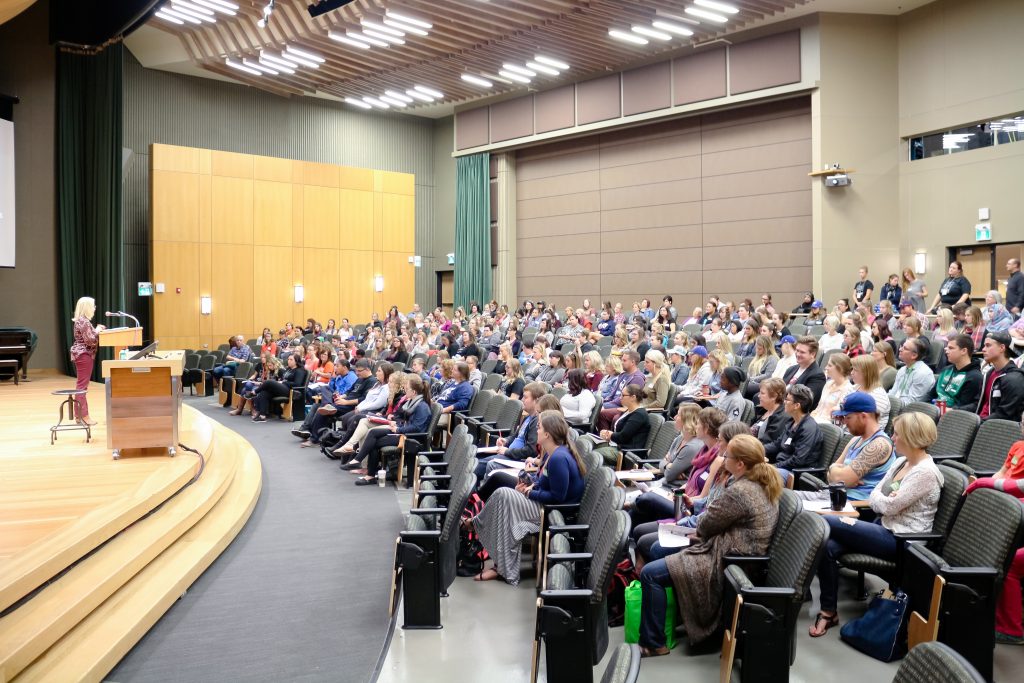
#TreatyEdCamp 2.0: Bigger and Better
An astounding number of preservice and in-service educators (over 300!) gathered together on Saturday, October 1 to take advantage of a great opportunity: to learn about treaty education at #TreatyEdCamp 2.0. Treaty education is mandatory in Saskatchewan curriculum and #TreatyEdCamp is professional development delivered “by teachers for teachers,” allowing educators to learn about treaty and how to implement treaty education in their classrooms.
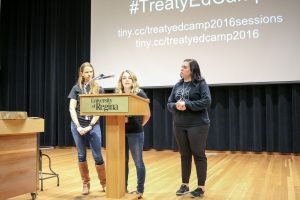
Katia Hildebrandt, Meagan Dobson and Raquel Bellefleur co-organized this second annual #treatyedcamp with the help of UR S.T.A.R.S. and many volunteers and with financial support from the Faculty of Education and the Aboriginal Student Centre.
Before participants went off to concurrent sessions (27 presentations over 4 sessions this year), Mike Desjarlais sang and drummed a song of remembrance, a reminder to participants to think of their loved ones who have gone before them. Dr. Jennifer Tupper spoke on the importance and need for treaty education, reminding participants of the recent murder of 22-year-old Colten Boushie of the Red Pheasant Reserve, which highlighted the racism that is prevalent in Saskatchewan, “still touching us all.” Education about what First Peoples have gone through at the hands of government — broken treaty promises that resulted in such losses as the loss of language and culture, loss of children to residential schools, and loss of loved ones to intergenerational trauma effects– will help to make changes that honour treaty rights, and someday will hopefully eradicate the issue of children in foster care and youth in gangs.
Brad Bellegarde, a Regina hip-hop artist and journalist, brought the Keynote presentation, “Hip Hop is the New Buffalo” after a lunch of soup and bannock. Bellegard expressed his desire to see the smiles on the faces of First Nation youth as they find relevance, self-expression and the ability to fight oppression through Hip Hop music. (See his video: https://youtu.be/TGZSBx3Ye5c). He also showed a youtube to demonstrate how music can bridge cultural gaps, creating opportunities to collaborate in schools. He encouraged teachers to ask about what they don’t know, just as he did when he went to Germany and Chile. “You’re teachers; you’re just like a big gang,” he said, “you can support each other.”
(See photo album by sliding cursor over the photo below and clicking on the arrow key)
If you couldn’t make a session, watch for the notes that will be posted for each session here: https://docs.google.com/document/d/1auBuAsi3sTIhfcaXBsoHz7aNdaO0z_W9mX8LViyXfEU/edit#
Orange Shirt Day in Faculty of Education
Pre-Intern Arts Ed PLACE Experience
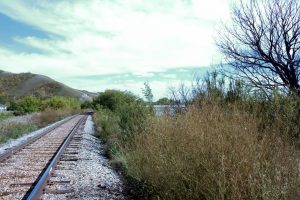 On September 15, pre-intern Arts Ed students met with Grade 8 Bert Fox Community High School students at Fort Qu’Appelle for the 30th Annual Treaty Four Gathering. There the Arts Ed students paired up and joined with an assigned group of Bert Fox students to take part in the tipi activities. After lunch, the students travelled to Lebret, to the site of the Lebret (Qu’Appelle) Indian Residential School. There they heard from Visiting Saskatchewan Artist Daya Madhur and Instructor Denise Morstad who spoke about the significance of the site, connecting it with Treaty 4 celebrations and the impacts of culture and language loss through residential schools.
On September 15, pre-intern Arts Ed students met with Grade 8 Bert Fox Community High School students at Fort Qu’Appelle for the 30th Annual Treaty Four Gathering. There the Arts Ed students paired up and joined with an assigned group of Bert Fox students to take part in the tipi activities. After lunch, the students travelled to Lebret, to the site of the Lebret (Qu’Appelle) Indian Residential School. There they heard from Visiting Saskatchewan Artist Daya Madhur and Instructor Denise Morstad who spoke about the significance of the site, connecting it with Treaty 4 celebrations and the impacts of culture and language loss through residential schools.
Students were encouraged to listen to and learn from the plants and land to create a sense of place in the art that they would produce later that day. (In preparation for this, they had watched Early Fall Medicine Walk with Elder Betty McKenna and If These Hills Could Talk: Daya Madhur)
In smaller groups, students listened to an audio recording of Dr. Shauneen Pete telling about her family’s experiences in the Lebret residential school and how those experiences have impacted generations.
Before students went out individually to explore the site, they were given tea sachets to scatter on a chosen spot as a ritual of asking for teaching from the natural environment. For the rest of the afternoon, students sketched, photographed, and recorded sounds from the environment. They came together again at the end of the day to share their art and reflections. After the Bert Fox students left, the pre-interns debriefed on their experience.
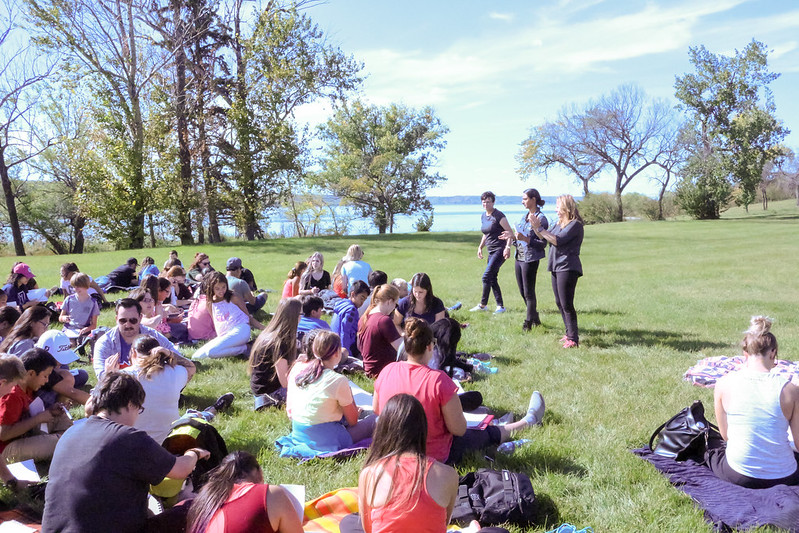
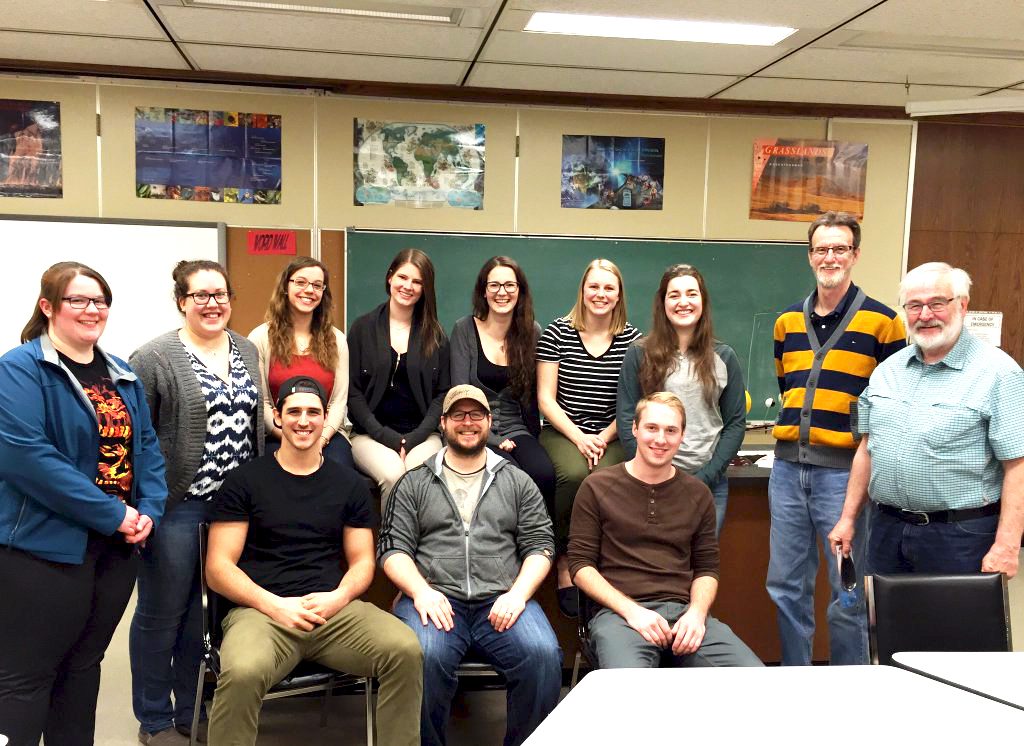
Preservice Science Educators Teach in Yorkton Tribal Council First Nation Schools
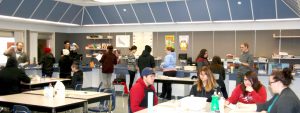 Science Education preservice teachers had the opportunity to take their learning on the road in the winter 2016 semester.
Science Education preservice teachers had the opportunity to take their learning on the road in the winter 2016 semester.
In December 2015, the Yorkton Tribal Council approached the Faculty of Education’s Dr. Shauneen Pete for assistance with science education. Dr. Pete asked Instructors John MacDonald and Michael McCoy, who were teaching secondary science education classes ESCI 350 and ESCI 351, to help out.
With MacDonald’s and McCoy’s support, preservice teachers taking ESCI 350 and 351 planned a two-day session from the Grade 10 curriculum on chemical reactions. Amy Martin explains, “As a class (all 10 of us), we constructed a science unit from scratch, and we actually got to go out and spend two full days teaching science on Kahkewistahaw First Nation and Keeseekoose First Nation reserves.”
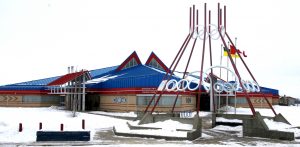 On February 4, the preservice teachers traveled to Chief Kahkewistahaw Community School for the Day 1 activities. Students from Kahkewistahaw, White Bear, Ocean Man, and Ochapowace First Nations participated in the session. The next morning they traveled from Yorkton, where they had stayed the night, to Keeseekoose Chief’s Education Centre. There they had opportunity to work with Grade 10 students from Keeseekoose and Cote First Nations.
On February 4, the preservice teachers traveled to Chief Kahkewistahaw Community School for the Day 1 activities. Students from Kahkewistahaw, White Bear, Ocean Man, and Ochapowace First Nations participated in the session. The next morning they traveled from Yorkton, where they had stayed the night, to Keeseekoose Chief’s Education Centre. There they had opportunity to work with Grade 10 students from Keeseekoose and Cote First Nations.
The following week, they repeated this schedule with Day 2 activities. (However, circumstances prevented them from returning to teach Cote First Nations the Day 2 activities.) The preservice teachers were pleased about this opportunity to work together to develop a series of activities that they also delivered, and the chance to teach at reserve schools, a first for all involved. Instructors John McDonald and Michael McCoy write, “As instructors, we were impressed by the professionalism displayed by our students: the extra work put into developing and organizing the activities, their ability to engage the students in the activities, their ability to reflect on the days activities and incorporate changes for the next day, all served to illustrate the quality of our future professional educators.” The preservice teachers involved were Mari-Anne Berriault, David Brown, Ryan Cherwaty, Shelby Fink, Jenna Hansen, Amy Martin, Laine McLaren, Zach Oleynik, Alyssa Walterson, and Ashley Wiley.
Preservice Teacher Comments:
The experience of teaching at the Kahkewistahaw and Keeseekoose Reserve schools was an eye opening one. The students had only really experienced science through what was taught in their textbooks, so being able to take part in hands on activities was a whole new world for them. It was rewarding to watch them open up throughout the day as they began to get excited about science.
~Alyssa Walterson
Teaching is a profession that is structured on experience. Therefore, as a beginning teacher, this experience was monumental at this point in our teaching career. The ability to experience a diverse culture and environment in a setting that many would not get to experience was a privilege. These short two days allowed me to apply the information being taught in the classroom in a real life setting. One of the most important aspects the experienced offered was the ability to cooperatively plan lessons with fellow students. We grew not only as individuals, but as a cooperative class in order to provide the best experience we could for the students. This to me was the most rewarding experience.
~Ryan Cherwaty
Teaching at the Kahkewistahaw and Keeseekoose Reserves was a great opportunity for us to build some experience working with students who have had very little exposure to science. As a group, we worked hard to design experiments that would engage the students, and spike some interest in a field that they have spent very little time with. For many of the students, this was the first time they were actively participating in hands on science experiments. As the day went on, it was great to see the students excited, engaged, and asking questions. I enjoyed having an opportunity to step out of my comfort zone, and teach in an environment that I have never been exposed to. Experiences like this will only strengthen our platforms as young educators.
~Zach Oleynik
It was a really great experience; my classmates and I were able to gain some experience in co-planning as we created mini lessons for the students. Since there were so many of us, we were able to split the students up into small groups for the lessons, which gave us opportunities to ask the students their thoughts and feelings about being taught science and what they thought about the lessons that we had created.
~Ashley Wiley
Photo Gallery
;
Faculty of Education to have a Tier II Canada Research Chair for Reconciliation Education
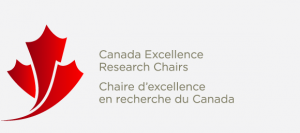 A special committee to the Provost has recommended a Canada Research Chair for Reconciliation Education for the the Faculty of Education, University of Regina. The Canada Research Chairs (CRCs) are established by the Canadian Government to foster research excellence (http://www.chairs-chaires.gc.ca/). Tier 2 Chairs are intended for exceptional emerging scholars with less than 10 years of active research in their field. Please consult the Canada Research Chairs website (https://www.chairs-chaires.gc.ca/about_us-a_notre_sujet/index-eng.aspx) for full program information, including further details on eligibility criteria.
A special committee to the Provost has recommended a Canada Research Chair for Reconciliation Education for the the Faculty of Education, University of Regina. The Canada Research Chairs (CRCs) are established by the Canadian Government to foster research excellence (http://www.chairs-chaires.gc.ca/). Tier 2 Chairs are intended for exceptional emerging scholars with less than 10 years of active research in their field. Please consult the Canada Research Chairs website (https://www.chairs-chaires.gc.ca/about_us-a_notre_sujet/index-eng.aspx) for full program information, including further details on eligibility criteria.
Canada Research Chairs Program is a tri-agency initiative of the Social Sciences and Humanities Research Council (SSHRC), the Natural Sciences and Engineering Research Council and the Canadian Institutes of Health Research. It is administered by the Tri-agency Institutional Programs Secretariat, which is housed within SSHRC.
The University Strategic Plan, peyak aski kikawinanw (together we are stronger), makes central indigenization and anti-colonial initiatives, which are further supported by the over 50 faculty members across campus who participate in the social justice and the health equity research clusters. The Faculty of Education is committed to strengthening and enhancing its efforts in reconciliation education and is already emerging as a national leader in this respect. Both the University and the Faculty of Education have expertise in several areas of anti-Colonial and Indigenous scholarship.
This position is now advertised at https://urcareers.uregina.ca/applicants/jsp/shared/position/JobDetails_css.jsp?postingId=195867
